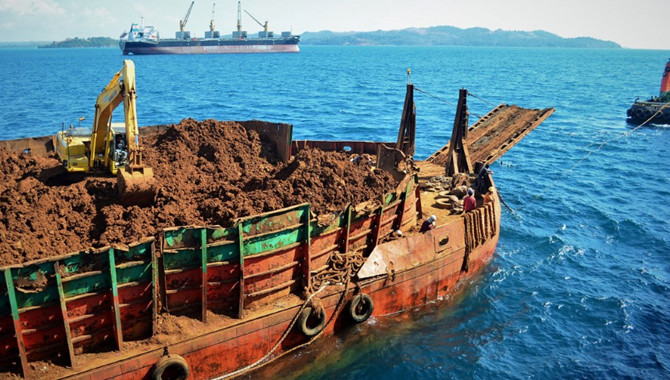
General
The period from April to November marks the traditional typhoon season in the waters of the Philippines and China, coinciding with the peak season for nickel ore transportation in the Philippines. Typhoons and tropical storms pose significant challenges to the safe shipment of nickel ore. These weather conditions increase the moisture content before loading and cause severe rolling and pitching during the voyage and which in turn may result in liquefaction and shifting of the cargo.
Recently, a vessel covered by Skuld experienced a cargo liquefaction incident while en route to the discharge port. A vessel covered by another Club also faced a similar incident.
Best practice
The liquefaction of nickel ore during shipment can be attributed to two key factors, the moisture content of the cargo and the rolling and pitching of the vessel during the voyage. These factors, one internal and the other external, are both necessary conditions for cargo liquefaction to occur. However, by effectively monitoring and controlling these factors, the risk of liquefaction can be significantly reduced.
Closely monitoring moisture content of the cargo during loading and carefully managing navigation during passage are the best practices for preventing liquefaction incidents in nickel ore shipments.
IMSBC Code compliance
Ensuring that the moisture content (MC) does not result in exceeding the Transportable Moisture Limit (TML) as required by the IMSBC Code is the critical quality control that should be implemented during the loading process.
Cargo monitoring will typically also include a pre-loading survey and guiding the crew to conduct Can Tests. However, it is important to understand that the Can Tests only provide a preliminary indication of the cargo condition at the loading site, and cannot replace laboratory testing to definitively determine whether the cargo is safe for carriage.
Due to complicating factors hampering safe loading of nickel ore loading in the Philippines, monitoring heavy relies on Can Tests there by making it difficult to ensure compliance with the IMSBC Code requirements. The IMSBC Code 8.4.2 clearly state that if samples remain dry following a can test, the moisture content of the materials may still exceed the Transportable Moisture Limit.
Nothing can replace full compliance with the IMSBC Code, but in addition the following factors are of relevance when it comes to the risk of liquefaction:
1. Vessels carrying nickel ore are usually Handy sized bulk carriers making them more prone to liquefaction than larger vessels.
2. Rough sea conditions intensify vessel rolling/pitching, increasing liquefaction likelihood and severity.
3. Investigations and analysis of previous cases show that liquefaction typically occurs after over 12 hours of continuous rolling/pitching in Force 6-7 winds and waves.
4. Forward holds experience more motion, so liquefaction often starts in holds 1 – 3.
5. Vessel pitching is more likely to induce liquefaction rather than rolling. However, once liquefaction occurs, rolling can cause cargo shifting, posing a greater danger to the vessel.
Passage planning and navigation precautions
1. Assess the weather and sea conditions before departure and prepare a passage plan to avoid ships sailing into bad weather above BF force 6-7. If encountering typhoons or tropical storms, avoid them early or drift safely until they pass.
2. Avoid or minimize ship pitching and rolling caused by wind and waves through adjusting course and speed. Consider coastal navigation to reduce the impact if needed.
3. Check condition of the cargo in each hold twice a day when weather permits. Record and report the cargo condition to the company.
4. If liquefaction is found, immediately report it to the ship managers and Skuld. Take immediate measures to reduce pitching and rolling, sail close to shore and choose the nearest port of refuge to deal with the cargo.
SMS procedures
Relevant procedures and guidelines must be established, and these guidelines should cover various aspects of nickel ore shipment, including:
·Can test, Oven-dry test, etc. and cargo controlling.
·Weather assessment and passage planning.
·Cargo inspection and reporting during the voyage.
·Liquefaction response and emergency procedures.
Based on the risk assessment, specific quantifiable requirements can be established, such as:
·Wind force and wave grades.
·Ship's rolling degree.
The procedures should be practical and feasible to be effectively implemented for safety.
The Master should also be aware of the obligations under the IMCBC Code to only allow safe and compliant cargoes to be loaded and members should follow the 'recommended precautions' listed in the 2011 IG circular for all cargoes that contain fine particles, irrespective of the cargo group declared by the shippers, and Members are reminded to comply with the 'notification requirements' of the 2012 IG circular, namely that members who plan to fix or charter a ship to load nickel ore from ports in Indonesia and the Philippines, or where under an existing fixture a ship is ordered to load such cargo, the member must notify Skuld at the earliest opportunity.
Source: Skuld
Source: Skuld
The opinions expressed herein are the author's and not necessarily those of The Xinde Marine News.
Please Contact Us at:







